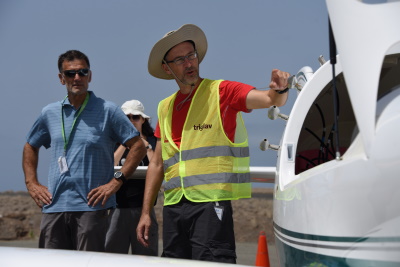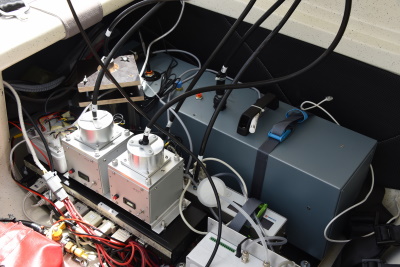- News
- Aerosol light absorption campa...
Aerosol light absorption campaign validates Aeolus data
23 Nov 2021

Calibration and Validation for Aeolus - Aerosols/Winds (CAVA-AW) was a scientific campaign carried out by the University of Nova Gorica on the island of São Vicente, Cape Verde, in September 2021, as part of the broader international framework of the Joint Aeolus Tropical Atlantic Campaign (JATAC).
CAVA-AW’s main objective was to support Aeolus validation and calibration through airborne aerosol in-situ observations in the lower troposphere, using an ultralight airplane. It aimed at measuring aerosol light absorption through calibrated filter photometers, aerosol light scattering through calibrated nephelometers, and aerosol size distribution through calibrated optical particle counters.
These measurements are particularly useful for validation of Aeolus data when it comes to the satellite’s detection of Saharan dust.
The secondary scientific objectives of the campaign aimed to shed light on the contributions of different anthropogenic and natural sources to the aerosol fine fraction, the complex mixtures of dust and carbonaceous aerosols in the coarse fraction in the West-African outflow and their effects on the climate through the calculation of the atmospheric heating rates for the different aerosol fractions.
The Cape Verde on-site campaign team consisted of pilot Matevž Lenarčič and scientist Griša Močnik from the University of Nova Gorica. All activities during the campaign were closely coordinated with other JATAC teams on Cape Verde and beyond, with a particular close collaboration with the ASKOS campaign team that was also based on São Vicente Island.
Flying light

The CAVA-AW campaign used an instrumented light airplane, Aerovizija’s Aerospool Advantic WT-10, to take measurements. Based out of Cesária Évora Airport on São Vicente Island, the Advantic WT-10 performed daily flights for the duration of the campaign. Both of the on-site CAVA-AW team members were aboard the airplane each time it flew.
Flights coincided with Aeolus overflights, but also with flights from the other two JATAC aircrafts flying out from the neighbouring Cape Verdean island of Sal: the AVATART campaign’s Falcon 20 and the CADDIWA campaign’s Safire Falcon. The Advantic WT-10 performed measurements from the ground to the mid-atmosphere, below the altitudes of the other two jet-aircrafts.
Innovative instrumentation for better resolution
The aerosol light absorption coefficient was measured with Continuous Light Absorption Photometers (CLAP) produced by Haze Instruments. CLAP photometers determine the absorption coefficient at three different wavelengths. These multiwavelength measurements can then be intercompared and calibrated with the photo-thermal interferometric direct measurement of the aerosol light-absorption coefficient in the laboratory.
Two instruments were used, one measuring the fine aerosol fraction and the other the enriched coarse fraction.
The aerosol light scattering and backscattering coefficients were measured with an Aurora 4000 nephelometer. The instrument was calibrated prior to the campaign with CO2 and was set up to measure only total scattering and backscattering coefficients, to preserve the time resolution of the measurements.

The size distributions in the fine and coarse sample line were measured with two Grimm 11-D Optical Particle Size Spectrometers (OPSS). Ancillary parameters, such as CO2 concentration, total and diffuse solar irradiance, temperature, and aircraft parameters such as GPS position, altitude, air and ground speed, were also measured.
Supporting instrumentation was used to measure the solar illumination and detect any increase in CO2, potentially indicating a combustion source. The pyranometer allowed CAVA-AW to determine the in-situ atmospheric heating rate and provide insight into the regional and local effects of this heating of the dust layers.
A successful campaign
Ten flights were conducted during the campaign, during two intense dust transport events. The two events were significantly different: one was extremely homogeneous in the vertical column over a large region, while the second featured dust layers, often less than 100 m thick, separated by layers of air with no dust.
“These contrasted situations will enable not just the in-situ validation of the satellite-borne and ground based lidars, but also the detailed characterisation of the atmospheric heating and cooling due to light absorbing and scattering aerosols,” says Griša Močnik, scientist from the University of Nova Gorica.
The campaign results will be presented at the Living Planet Symposium in May 2022.